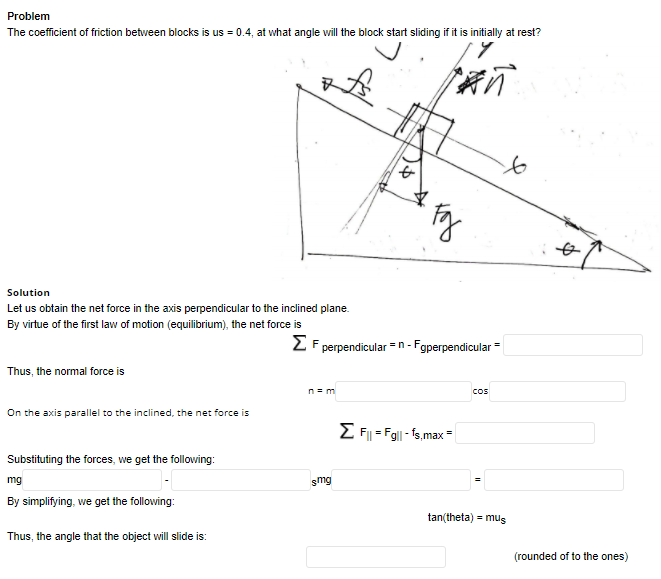Problem The coefficient of friction between blocks is us = 0.4, at what angle will the block start sliding if it is intially at rest? to Solution Let us obtain the net force in the axis perpendicular to the inclined plane. By virtue of the first law of motion (equilibrium), the net force is E F perpendicular =n - Fgperpendicular = Thus, the nomal force is cos n= m On the axis parallel to the inclined, the net force is E F = Fg| -s,max = Substituting the forces, we get the following:
Problem The coefficient of friction between blocks is us = 0.4, at what angle will the block start sliding if it is intially at rest? to Solution Let us obtain the net force in the axis perpendicular to the inclined plane. By virtue of the first law of motion (equilibrium), the net force is E F perpendicular =n - Fgperpendicular = Thus, the nomal force is cos n= m On the axis parallel to the inclined, the net force is E F = Fg| -s,max = Substituting the forces, we get the following:
College Physics
10th Edition
ISBN:9781285737027
Author:Raymond A. Serway, Chris Vuille
Publisher:Raymond A. Serway, Chris Vuille
Chapter4: The Laws Of Motion
Section: Chapter Questions
Problem 70AP: Measuring coefficients of friction A coin is placed near one edge of a book lying on a table, and...
Related questions
Topic Video
Question
What's this?

Transcribed Image Text:Problem
The coefficient of friction between blocks is us = 0.4, at what angle will the block start sliding if it is initially at rest?
to
Solution
Let us obtain the net force in the axis perpendicular to the inclined plane.
By virtue of the first law of motion (equilibrium), the net force is
E F perpendicular =n - Fo
gperpendicular
Thus, the normal force is
n = m
cos
On the axis parallel to the inclined, the net force is
E F = Fg|l - 5,max
Substituting the forces, we get the following:
mg
smg
By simplifying, we get the following:
tan(theta) = mus
Thus, the angle that the object will slide is:
(rounded of to the ones)
Expert Solution
This question has been solved!
Explore an expertly crafted, step-by-step solution for a thorough understanding of key concepts.
Step by step
Solved in 3 steps with 3 images

Knowledge Booster
Learn more about
Need a deep-dive on the concept behind this application? Look no further. Learn more about this topic, physics and related others by exploring similar questions and additional content below.Recommended textbooks for you

College Physics
Physics
ISBN:
9781285737027
Author:
Raymond A. Serway, Chris Vuille
Publisher:
Cengage Learning

University Physics Volume 1
Physics
ISBN:
9781938168277
Author:
William Moebs, Samuel J. Ling, Jeff Sanny
Publisher:
OpenStax - Rice University

Physics for Scientists and Engineers: Foundations…
Physics
ISBN:
9781133939146
Author:
Katz, Debora M.
Publisher:
Cengage Learning

College Physics
Physics
ISBN:
9781285737027
Author:
Raymond A. Serway, Chris Vuille
Publisher:
Cengage Learning

University Physics Volume 1
Physics
ISBN:
9781938168277
Author:
William Moebs, Samuel J. Ling, Jeff Sanny
Publisher:
OpenStax - Rice University

Physics for Scientists and Engineers: Foundations…
Physics
ISBN:
9781133939146
Author:
Katz, Debora M.
Publisher:
Cengage Learning

Glencoe Physics: Principles and Problems, Student…
Physics
ISBN:
9780078807213
Author:
Paul W. Zitzewitz
Publisher:
Glencoe/McGraw-Hill

College Physics
Physics
ISBN:
9781938168000
Author:
Paul Peter Urone, Roger Hinrichs
Publisher:
OpenStax College